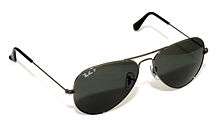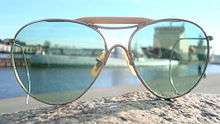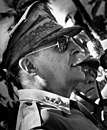Aviator sunglasses
Aviator sunglasses are a style of sunglasses that were developed by Bausch & Lomb. The original Bausch & Lomb design is now marketed as Ray-Ban Aviators, although other manufacturers also produce aviator-style sunglasses.

Design
Aviator sunglasses intended to be worn under headgear are characterised by dark, sometimes reflective lenses having an area two or three times of area of the eyeball, and very thin monel, steel or titanium metal frames with double or triple bridge and bayonet earpieces or flexible cable temples that hook more securely behind the ears.[1] The large lenses are not flat but slightly convex. The design attempts to cover the entire range of the human eye and prevent as much light as possible from entering the eye from any angle.
History
AN6531 military sunglasses

In the second half of the 1930s and early 1940s, a group of American firms were developing sunglasses. The military "flying sun glasses (comfort cable)" were standardized in November 1941. They were produced in huge quantities (several million pieces) for pilots and sailors. The lenses were made to a joint standard shared by the U.S. Army Air Corps and the U.S. Navy. As a result the lens carried an "AN" (Army/Navy) specification number: the AN6531. The U.S. Government specified the shape of the lens and the color, which was initially a 50% green tint. This tint proved insufficient to protect pilot’s eyes from sun glare so this lens was superseded by the darker AN6531 Type 2 lens in rose smoke. Various contractors made the frames and ground the lenses. These included American Optical, Bausch & Lomb, The Chas. Fischer Spring Co., Willson Optical and Rochester Optical Co. Frame and hinge design varied slightly from contractor to contractor.[2] Despite being designed for utility, these glasses had advanced properties: teardrop-shaped and convex lenses, plastic nose pads and a prominent brow bar and featured flexible cable temples. The nickel plated frame was made of a copper based alloy to prevent offsetting compasses. the "teardrop" shape lens of the AN 6531 was designed to accommodate Air Force pilots who were constantly looking down at their instrument panel while in flight, and influenced all future Aviator style lens shapes. After World War II AN6531 Comfort Cable aviator sunglasses were available for civilians on the surplus market.[2]
The AN6531 Comfort Cable aviator sunglasses model kept being issued by the U.S. military as Type F-2 (arctic) and Type G-2 aviator sunglasses after World War II but fitted with darker lenses until their substitute the Type HGU-4/P aviator sunglasses became available.[3][4]
Subsequently, civilian models and options appeared without a frontal brow bar and with plastic earhooks. Since everything military was in fashion in those years, these glasses became popular among the people and the two companies got their bearings on time and began to promote such glasses for civilian use in the 1940s and 1950s.
Bausch & Lomb
In 1929, US Army Air Corps Colonel John A. Macready worked with Bausch & Lomb, a Rochester, New York-based medical equipment manufacturer, to create aviation sunglasses that would reduce the distraction for pilots caused by the intense blue and white hues of the sky.[5][6][7] Specifically, MacCready was concerned about how pilots' goggles would fog up, greatly reducing visibility at high altitude.[8] The prototype, created in 1936 and known as "Anti-Glare", had plastic frames and green lenses that could cut out the glare without obscuring vision. Impact-resistant lenses were added in 1938.[9]
Commercial history
Ray-Ban Aviator
.jpg)

The sunglasses were redesigned with a metal frame in 1939 and patented by Bausch & Lomb as the Ray-Ban Aviator.[8] According to the BBC, the glasses used “Kalichrome lenses designed to sharpen details and minimise haze by filtering out blue light, making them ideal for misty conditions.”[8] At the time Ray-Ban was a civilian division of Bausch & Lomb. This style of sunglasses is credited with being one of the first popularized style of sunglasses to be developed.[12] In its military usage, the sunglasses replaced the outmoded flight goggles used previously, as they were lighter, thinner, and “more elegantly designed”. Writing about the transition of aviators from military gear to a commercial product, Vanessa Brown wrote that, “The War was a … revelation of the sheer might, scale, power, and horror of the modern world … [which] necessitated a new kind of military demeanor and gave rise to new definitions of the heroic stance which was to have a profound influence on modern fashion.”[13] Eventually, the aviator sunglasses produced by Bausch & Lomb were trademarked as “Ray Bans”.[14]
Aviators became a well-known style of sunglasses when General Douglas MacArthur landed on a beach in the Philippines in World War II[15] and newspaper photographers snapped several pictures of him in October 1944 wearing them that became a lasting image of the Second World War.[16] Bausch & Lomb dedicated a line of sunglasses to him in 1987.[11]
The first advertisements for Ray-Ban Aviators stated they would provide “real scientific glare protection” and were sold as sporting equipment. At this time, they had not yet taken on their name of “aviators”, the Second World War having not yet begun. In addition to popularity in the 1950s, aviators were popular in the 1970s and 1980s, being worn by public figures like Slash, Michael Jackson , George Michael, Tom Cruise, Freddie Mercury, Jeff Lynne, Roger Waters and Elvis Presley.[17] During the 1950s, aviator sunglasses were a part of the cultural style, mimicking military style.[18]
Besides flexible cable temples and bayonet temples non-military issed glasses often feature traditional skull temples.[19][20][3]
Ray-Ban Aviator sunglasses variations
_Size_62_09_160_Lens_base_6.jpg)

Besides the standard model there are several different Ray-Ban Aviator sunglasses variations designed as functional, technical and recreational sunglasses . The Ray-Ban Shooter variant was inroduced in 1938 and the Ray-Ban Outdoorsman variant in 1939. These sunglasses both feature a large brow bar above the nose intended to keep sweat and debris from inhibiting the wearer's vision.[21] The brow bar and temple end pieces of the Shooter and Outdoorsman variants have been covered through years with different materials. Aimed at the sports enthusiast and outdoorsman, The Ray-Ban Shooter variant incorporates a cigarette holder, a circular device located at the center of the nose bridge. Originally intended to support the sportsmans cigarette, whilst taking aim or needed the use of both hands, in the 21st century the cigarette holder is often referred to as a vanity bullet hole. In 1953 Ray-Ban introduced G-15 tempered glass lenses. These neutral green/gray lenses transmit 15% of incoming visible light whilst providing 'true' color and contrast distribution.[22]
Type HGU-4/P aviator sunglasses



In 1958 American Optical created the Flight Goggle 58 according to the than new U.S. Air Force Type HGU-4/P aviator sunglasses standard.[4] Type HGU-4/P sunglasses feature lenses with less lens surface area and are lighter compared to the preceeding Type G-2 sunglasses and additionally feature bayonet temples designed to slip easily under a flight helmet or other headgear and were more compatible with oxygen masks. The are commercially know as "Original Pilot Sunglass", and were issued by the US military to pilots since 1958.[3] By 1982, Randolph Engineering had become the prime contractor for military-style Type HGU-4/P aviation flight glasses for the United States Department of Defense.[23]
References
| Wikimedia Commons has media related to Aviator glasses. |
| Wikimedia Commons has media related to People with aviator glasses. |
| Wikimedia Commons has media related to Ray-Ban Aviator. |
- Ray-Ban New Materials #2, luxottica.com, 2 October 2014
- "Who really made those WWII aviator sunglasses? Part 5 of our investigation". 9 June 2014.
- "The History of Aviator Sunglasses, Part 7 – The Air Force HGU-4/P". 30 June 2014.
- "ATBG-DT AVN 558 SUBJECT: Report of Test, Project Nr AVN 5558, "Expedited Evaluation of the US Air Force Type HGU-h/P Sunglasses"" (PDF). 1959.
- Pagan Kennedy (3 August 2012). "Who Made Those Aviator Sunglasses?". New York Times. Archived from the original on 21 August 2012. Retrieved 1 May 2017.
And so Macready began working with Bausch & Lomb to design goggles especially suited to protect against the dazzle in the stratosphere. “My dad gave Bausch & Lomb the original shape, tint and fit” of aviator lenses, Wallace said.
- "The best ever ray-bans". Archived from the original on 2015-11-22. Retrieved 2020-06-19.
- "You can thank the US military for the world's most famous sunglasses". Business Insider France (in French). Retrieved 2017-05-24.
- Foreman, Katya. "The enduring appeal of aviator sunglasses".
- "Fashion Notes". 24 May 1987. Archived from the original on 18 October 2016. Cite journal requires
|journal=(help) - Gary S. Messinger: The battle for the mind – War and peace in the era of mass communication. University of Massachusetts Press, Amherst 2011, ISBN 978-1-55849-853-2. p. 131–132
- Christopher Klein: 10 Things You May Not Know About Douglas MacArthur. On May 22, 2014 at history.com
- Jr, Anthony Rubino (18 March 2010). "Why Didn't I Think of That?: 101 Inventions that Changed the World by Hardly Trying". Adams Media – via Google Books.
- Brown, Vanessa (18 December 2014). "Cool Shades: The History and Meaning of Sunglasses". Bloomsbury Publishing – via Google Books.
- Segrave, Kerry (23 March 2011). "Vision Aids in America: A Social History of Eyewear and Sight Correction Since 1900". McFarland – via Google Books.
- Arthur Asa Berger: Media and communication research methods – An introduction to qualitative and quantitative approaches. Sage, Thousand Oaks 2011, ISBN 978-1-4129-8777-6. p. 66–67
- "The Oxford Encyclopedia of American Military and Diplomatic History". OUP USA. 31 January 2013 – via Google Books.
- "Who Made Those Aviator Sunglasses?". The New York Times. 5 August 2012.
- Frum, David (1 January 2008). "How We Got Here: The 70s The Decade That Brought You Modern Life--For Better Or Worse". Basic Books – via Google Books.
- U.S. Patent D292,984
- Bayonet vs Skull Aviator Temples For Sunglasses by John M. White, 18 July 2015
- Comparing and identifying the Ray-Ban 3025, 3029, 3030, 3407 and 3422 sunglasses
- RAY-BAN: THE HISTORY OF THE TOP-SELLING EYEWEAR BRAND WORLDWIDE
- "Made with the shades: Randolph Engineering grows as its sunglasses get noticed". Boston Business Journal. September 16, 2011. Retrieved January 23, 2012.